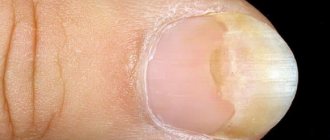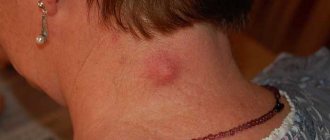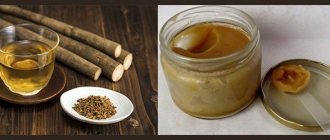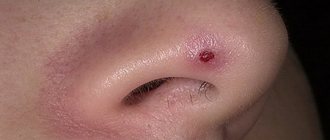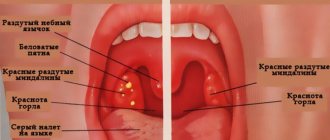The beginning of a runny nose indicates the presence of an immune response to the penetration of an infectious agent into the body. Rhinitis - the medical definition of a runny nose - is nothing more than inflammation of the nasal mucosa.
If timely treatment measures are taken, a runny nose is absolutely not dangerous and does not entail anything other than physical discomfort, a feeling of fatigue and decreased performance for up to five days.
There are many ways to effectively and quickly cure a runny nose in children and adults. We will tell you which ones in this article.
This article provides only general recommendations. Treatment methods must be agreed with your doctor.
Types of runny nose
Otolaryngologists distinguish seven types of runny nose, namely:
- Vasomotor (chronic). May occur as a result of the body’s reaction to seasonal infections, alcohol consumption, strong odors, house dust, etc.
- Allergic (subtype of vasomotor). It appears when allergens enter the body.
- Infectious etiology:
- viral,
- bacterial.
- Medication. Occurs when overuse of vasoconstrictor drops and sprays.
- Chronic. Develops as a result of injury or unsuccessful surgery.
- Hypertrophic. It manifests itself in the form of proliferation of the mucous membrane and tissues that form the nasal turbinates due to exposure to dust and harmful gases.
- Atrophic. It manifests itself in the form of atrophy of the nasal mucosa and the nerve endings present in it with the formation of fetid crusts. It occurs as a complication after viral infections, vitamin deficiency and due to hormonal disorders.
The acute form of rhinitis in most cases is easily and completely cured. If you do not pay attention to a prolonged runny nose, accompanied by a deterioration in well-being, the disease becomes chronic and entails the addition of a bacterial infection: sinusitis, inflammation of the middle ear, otitis media, etc.
A set of measures to eliminate runny nose
It is possible to cure rhinitis in 2 days, but only if therapy is started in a timely manner. Considering that a runny nose is often the body’s first reaction to hypothermia, warming should be an emergency measure. After coming from outside, you should immediately take a hot bath. You can add dry mustard powder to the water.
You should take a bath immediately after coming home; if you do it after a couple of hours, there will be no effect.
After warming water procedures, you need to rinse your nose with saline solution. Salt absorbs toxins and bacteria, which immediately helps clear the nasal passages.
After rinsing, you need to instill vasoconstrictor nasal drops or use a spray.
The combination of these three measures is a guarantee that the next day there will be no trace of the symptoms of a runny nose.
Stages of a runny nose
From the moment you encounter an infection until the symptoms of the disease completely disappear, there are three stages of rhinitis. The duration of the disease is associated with the timing of the body's production of antibodies and interferons - substances aimed at destroying the infection.
We list the three stages of acute rhinitis:
- Initial (reflex, dry stimulation phase). At this stage, a pathogenic agent penetrates the nasal mucosa, causing dilation of the blood vessels of the epithelium and mild swelling. The mucosal surface remains dry.
Characteristic symptoms are:
- dryness,
itching with sneezing,
- burning sensation,
- headache,
- difficulty in nasal breathing,
- slight increase in temperature (rare).
- Catarrhal (wet, phase of serous discharge). It is characterized by an increase in the permeability of the mucosa and the outflow of lymph from the vessels into the tissue, which entails severe swelling.
Characteristic symptoms are:
- clear nasal discharge;
irritation under the nose and on the upper lip;
- tearfulness;
- inability to breathe through the nose;
- hoarse timbre of voice;
- decreased taste, smell and appetite;
- temperature increase.
- Third (final). Occurs on the fifth day from the onset of the disease. Accompanied by copious discharge of thick viscous transparent mucus. At this stage, with proper treatment, recovery occurs within two days.
However, if a runny nose is not treated, then a bacterial infection may occur at the third stage. In this case, nasal discharge becomes cloudy, yellow or greenish in color, and has a strong, unpleasant odor. The temperature rises, health worsens.
If the course of the disease takes this form, you should consult a doctor. As a rule, in this case, a course of therapy with antibacterial drugs - antibiotics or bacteriophages - is prescribed.
It is difficult to quickly identify signs of the onset of rhinitis in very young children, except in cases of increased body temperature.
The duration of the reflex stage varies from several hours to a couple of days. If you have good immunity, timely recognition of unpleasant symptoms and take appropriate measures at this stage, you can prevent the development of rhinitis.
The catarrhal stage usually lasts two to three days.
How to cure a runny nose quickly and effectively
Depending on the cause of the runny nose, the patient is prescribed certain medications in the form of drops. They are divided into several groups:
- Vasoconstrictors. These are the quickest helpers for a runny nose, but with prolonged use they become addictive. Such drugs are symptomatic.
- Combined. Such drops have several actions. They can be used for longer than 14 days, because they do not affect arteries and veins.
- Antihistamines. The indication for their use is a runny nose due to an allergic reaction. They inhibit the action of histamines and immune cells. This eliminates allergies.
- Hormonal. If the symptom cannot be treated with antihistamines and vasoconstrictors, then medications from this category are prescribed. Hormonal drops are also fast-acting, but they are prescribed only by a doctor due to their complex composition and possible side effects.
- Homeopathic. These drops have an immunostimulating, anti-inflammatory, anti-edematous and antiviral effect.
Vasoconstrictor nasal agents
When the patient is tormented by copious liquid discharge from the nose and severe congestion, vasoconstrictor drops are prescribed. They act instantly, eliminating swelling of the mucous membrane and increasing ventilation of the sinuses. Doctors recommend using vasoconstrictor sprays, which are distributed more evenly. Drugs from this category eliminate congestion, but are addictive and dry out the mucous membrane, so they are not used for more than a week. There are several groups of vasoconstrictor drops:
- with phenylephrine - Polydexa spray, Irifrin, Nazol Kids (valid for 6 hours);
- with naphazoline - Naphthyzin, Rinosept, Sanorin (valid for 4 hours);
- with xylometazoline - Galazolin, Otrivin, Tizin (valid for 10 hours);
- with oxymetazoline - Nazol, Nazivin, Nesopin (valid for 12 hours).
Combined products
The name of these drugs is due to their composition, which includes several components. Some drops even contain antibiotics, for example, Gtncomycin-Teva. The course of treatment with such drugs is determined by the doctor. The vasoconstrictor effect of the drugs lasts about 4 hours. Known combination drops:
- Vibrocil;
- Polydex;
- Septonasal;
- Snoop.
Antihistamines
Antiallergic drops begin to act quickly - 15-30 minutes after use. The indication for their use is considered to be only rhinitis of an allergic nature. These drops are:
- Sanorin Analergin;
- Cromohexal;
- Cromoghlin;
- Lazol Nazal Plus.
- 10 Anti-Inflammatory Foods
- Plastic cellar - advantages and disadvantages, varieties with description, size and cost
- 7 signs your body doesn't have enough water
The category of antihistamines also includes systemic drugs. They also help cope with a runny nose. Doctors prescribe such medications for the purpose of complex treatment of nasal inflammation - rhinitis or sinusitis. Representatives of systemic antihistamines are:
- Zodak;
- Allerzin;
- Cetrin;
- Zyrtec;
- Erius.
Hormonal drops and sprays
The effect of hormonal drugs begins 12 hours after instillation. The therapeutic effect does not go away quickly - it is observed throughout the day. Hormonal drops cope with a runny nose of any nature. They, unlike vasoconstrictors, do not lead to addiction. This category of drops includes:
- Flixonase;
- Budesonide;
- Aldecin;
- Benorin;
- Baconase.
Homeopathic remedies
The peculiarity of homeopathic drops is the minimum of side effects after their use. They are used regardless of the stage of the runny nose. The basis is special substances that are useful only in small doses, and in large doses, on the contrary, harm the body. Homeopathy is safe even for children and pregnant women. Among her remedies against the runny nose are:
- Edas-131;
- Delufen;
- Euphorbium Compositum.
Causes of a runny nose
The causes of a runny nose in children and adults are similar. The pathogen that penetrates the nasal mucosa and causes an infectious-inflammatory process is most often of a viral or bacterial nature.
Also, an attack of acute rhinitis can be triggered by contact with an irritating allergen.
Other causes of a runny nose:
- hormonal disorders;
- exacerbation of chronic diseases of the nasal cavity;
- weak immunity;
- long-term use of certain medications;
- sudden climate changes.
If the prerequisites for the occurrence of a runny nose are not obvious, you can always use modern diagnostic methods, including PCR studies of smears from the nasal cavity and pharynx, a general blood test with leukocytogram, fibro- and endoscopy, ultrasound, etc. For these and other types of patient tests directed by the attending physician - therapist or otolaryngologist.
Treatment of a runny nose with pharmaceuticals
In the medical treatment of a runny nose, the following drugs are used individually or in combination:
- Vasoconstrictor sprays are topical pharmaceutical preparations to relieve swelling and restore normal nasal breathing. Some sprays contain additional active components: hormones, antibiotics, immunomodulators, antihistamines, etc.
- Sprays based on sea water, additionally enriched with minerals and emollients. They act as local antiseptics, sanitize and moisturize the nasal mucosa, and kill some types of pathogens.
- Nasal vasoconstrictor drops. They have the same composition and purpose as sprays, but differ somewhat in the method and area of impact. If any spray irrigates exclusively the surface of the nasal mucosa, then the drops penetrate deeper, affecting the endothelium, and also flow down the mucosa, involving the nasopharynx in the therapeutic process.
- Pills. This group of drugs includes countless medications for various purposes: antiviral, immunomodulatory, antibacterial, antihistamine, anti-inflammatory, analgesic, etc.
All of the above remedies must be used after consulting with your doctor.
Home remedies for getting rid of runny nose
You can quickly cure a runny nose in a child and an adult at home by taking the following effective measures:
- Washing.
They allow you to clean and moisturize the nasal mucosa and prevent the formation of microcracks.
List of contraindications for rinsing:
- deviated septum,
obstruction of the nasal passages,
- acute otitis media,
- the presence of neoplasms in the nasal cavity,
- nosebleeds.
The following products can be used for rinsing:
- saline,
- pharmaceutical solution of sea salt,
- isotonic drops and sprays.
The washing procedure can be carried out using a special Dolphin device, a syringe without a needle, or a regular pipette. Many pharmaceutical preparations are sold in special cans with sprayers that allow the product to be delivered into the nasal cavity under pressure and in the required quantity.
This treatment method can only be used to treat viral rhinitis.
For bacterial infections accompanied by fever and purulent discharge, heating is strictly contraindicated!
Warming can be done using two linen or cotton bags with fine salt. The bags must be heated in a frying pan to a very warm temperature, then applied to the wings of the nose and kept until completely cool. Warm hard-boiled eggs wrapped in thick cloth will also work.
Warming up improves blood circulation in the nasal cavity, which reduces swelling and normalizes breathing.
This treatment method involves inhaling healing steam infused with herbs or medications. Inhalations can be warm or cold.
Cold inhalations are carried out using a nebulizer - a special device that ensures deep penetration of the inhalation composition into the bronchi and lungs. The composition for nebulizer inhalation is usually prepared on the basis of saline solution with the addition of menthol, essential oils or medications.
Classic warm inhalations are more superficial. To carry out the procedure, you need to prepare the composition by brewing medicinal herbs in boiling water. Then you should remove the broth from the heat and inhale the healing steam, bending over the container and throwing a thick towel over your head. You can also pour a small amount of the decoction into a regular teapot and inhale the steam through your nose and mouth.
How to quickly cure a runny nose at home
To begin with, it is worth noting that a runny nose does not always appear due to a cold or flu. It can also be allergic and vasomotor. The first is manifested by swelling of the nasal cavity and throat, the release of “water”, enlargement of the sinuses and redness of the skin in this area. The second is associated with impaired blood vessel tone. It manifests itself as clogged airways on one (either) side. When you change your body position, the congestion may move to the second sinus or disappear completely. Rarely, it manifests itself as nasal discharge.
Accordingly, treatment for a runny nose at home should be selected based on the cause and type of rhinitis. Whatever it is, it cannot be ignored, especially the situation in children.
Important! Untreated runny nose in children can cause acute otitis media and sinusitis. Similar diseases can develop due to improper blowing of the nose (a handkerchief brought to the nose is tightly pinched, as a result of which sputum “flies” into the ear canal while blowing the nose).
Please note that if you consulted a doctor and he made a prescription, follow the prescription and do not resort to additional measures without first consulting a doctor. Unfortunately, many people underestimate the power of herbal remedies and folk “poultices,” which is why they harm their body. Remember that, unlike pharmacological drugs, folk remedies are not dosed, and therefore may be more concentrated than required.
Now let’s look at what effective remedies for the common cold can be prepared at home and how to use them safely:
- saline solution: dissolve sea salt in water in a ratio of 1 tsp. salt per 1 liter of water. Instill the resulting liquid into the nose to thin the thick mucous masses of the nasal cavity or to rinse it. The latter is only suitable for adults. For teenagers and older children - only after consulting a doctor;
- Kalanchoe juice. Wash a couple of elastic leaves of the plant, chop and squeeze out the juice. Apply the resulting product to your nose several times a day. The course of instillation is until nasal breathing improves;
- sea buckthorn oil. Using a pipette, drop into each sinus of the nose after inhalation. Choose high-quality pure sea buckthorn oil;
- inhalation. Take several types of pine needles and brew them in boiling water or put them in a special inhaler tank. Breathe first through your nose and then through your mouth over the hot steam. If desired, you can add essential oils of orange, lemon, mint or eucalyptus to the decoction. After a while, you can drip it with sea buckthorn oil.
Attention! If there is a violation of the tone of the blood vessels of the nasal cavity, a tendency to bleeding, do not use inhalation.
The latter method is very effective for a runny nose due to a cold. It has been proven that heat promotes the drainage of mucus and thereby speeds up recovery. In addition, get rid of a runny nose at home using heat using a bag of salt or boiled eggs.
Recipe 1. Pour two tablespoons of any salt into a hot frying pan, heat it up a little and pour into a linen bag (you can take a cotton handkerchief or sock). Apply to the sinuses several times one at a time until the salt cools down.
Recipe 2. Boil a couple of eggs, cool them slightly to a pleasantly hot temperature and apply to your sinuses.
These recipes are effective for both adults and children over 5-6 years old without pathologies of the nose and blood vessels.
How to quickly cure a runny nose in a child
To rinse the nose in children, it is necessary to use sprays with a “soft shower” type nozzle. Jet sprays are not recommended for children under three years of age! A solution given in large quantities and under strong pressure can get from the nasopharynx into the ear and cause inflammation.
Cleaning the nasal cavity when a baby has a runny nose requires special attention. If nasal breathing is impaired, the baby will not be able to sleep and latch on.
To clean your newborn's nose, use a seawater nasal spray with a gentle shower attachment. Give one spray into each nostril. You can also use a drug with a similar effect in the form of drops, dropping two into each nostril with a pipette. As a result, the crusts in the nasal passages will soften and can be easily removed with a cotton swab or using a nasal aspirator.
It is especially dangerous to “start” a runny nose in childhood. In children, the nasal mucosa is characterized by increased friability and the presence of a large number of blood and lymphatic vessels. With a viral infection, edema develops much more rapidly in children than in adults and is accompanied by copious mucus formation.
If the condition worsens and the body temperature rises, it is recommended to show the child to a pediatrician as soon as possible.
How to quickly cure a runny nose using folk remedies
The following folk remedies have proven themselves to be excellent as part of complex therapy for the runny nose:
- Self-prepared drops with antiseptic and anti-inflammatory properties that help relieve swelling and improve blood circulation:
- aloe or Kalanchoe juice in combination with water 1:3;
olive or peach oil;
- a strong decoction of chamomile, calendula, yarrow and other herbs;
- raw carrot or beet juice diluted with water;
- a mixture of honey and mint oil in a 2:1 ratio:
- a mixture of honey and onion juice in a ratio of 2:1.
- Onion and garlic. These vegetables are rich in antioxidants and phytoncides. They can be used as follows:
- eating raw;
insertion of turundas (narrow gauze swabs) soaked in garlic or onion gruel into the nose (previously drip Vaseline);
- instillation of undiluted onion juice into the nose (effective at the initial stage of rhinitis).
- Honey and bee products. They are characterized by powerful immunostimulating and anti-inflammatory effects. They can be consumed instead of sugar with warm herbal tea or milk. Propolis is added to washing solutions.
- Mustard. The therapeutic effect is ensured by its unique ability to retain heat. Mustard powder can be used for foot baths, inhalations, or sprinkled into cotton socks at night to warm the feet.
- Beverages. For respiratory diseases, the maximum proportion of the total volume of fluid consumed per day should be clean water. However, all kinds of herbal teas, rosehip decoction, fruit drinks based on cranberries and currants and other vitamin drinks will not be superfluous.
When treating a runny nose, many people neglect to follow such important rules as drinking regimen and diet. Lack of water causes thickening and stagnation of mucous secretions in the nasal passages with the formation of dense crusts, which interferes with the normal function of the protective mechanisms in the nasal cavity. If rhinitis is accompanied by fever, then insufficient fluid intake can cause dehydration.
For any viral infection, you should consume at least two liters of clean water per day. It will also promote active detoxification and faster transport of nutrients and oxygen to the cells by thinning the blood.
As for nutrition, a protein-free diet is optimal for a runny nose. Carbohydrates are easier to digest and absorb, allowing the body to save effort to more effectively fight the virus. In addition, protein-free nutrition significantly relieves the lymphatic system - the stronghold of the immune system - and improves liver function.
Quick treatment of a runny nose using traditional methods
Traditional medicine also offers effective methods to cure a runny nose. There are many recipes based only on natural ingredients. The very first aid when you feel a runny nose approaching will be the following:
- Take two mustard plasters, apply them to your feet, and put on socks made of natural wool on top. Leave them for 2 hours, then walk for a minute at a fast pace and go to bed.
- Draw an iodine mesh on the heels, put on socks with mustard sprinkled in advance.
- Drop 2-3 drops of aloe juice into your nose every day.
Onion and garlic juice
Inhaling the vapors of crushed garlic and onions helps to quickly cure a runny nose. These vegetables can simply be added to food or used for nasal drops. For this you need onion or garlic juice:
- Peel the onion or garlic head;
- then finely chop with a knife or grate, then squeeze through several layers of gauze;
- if necessary, you can dilute the juice with water in a 1:1 ratio;
- Instill the finished product into the nose, 1-2 drops for each nostril up to 3 times a day.
Horseradish and mustard
These products have a pungent odor that helps cure a runny nose quickly. They have an irritating effect on the mucous membrane, causing severe sneezing, and as a result, the nose is cleared of mucus. Fresh horseradish must be crushed using a meat grinder, then add a little mustard, and then breathe over their vapors. These products can simply be consumed as additional food.
Carrot and beet juice
It is better to prepare carrot or beet juice before instillation. The product should be used 3-4 times a day, 1-2 drops in each nostril. Recipes for making drops:
- chop and squeeze carrots or beets to get 100 ml of juice;
- mix them with honey in a 3:1 ratio.
Aloe and Kalanchoe juice
Drops are prepared from the juice of these medicinal plants. They are instilled into the nose up to 3-4 times a day. An additional component in this folk remedy is honey, but it is contraindicated for allergy sufferers. Preparing the drops is simple - you need to squeeze 2-3 tsp from the leaves of aloe and Kalanchoe. juice Then a little honey is added to them. The finished product should be dripped 2 drops into each nostril.
How to quickly cure a persistent runny nose
A poorly treated runny nose is fraught with the development of complications, including bronchitis, nasopharyngitis, sinusitis, sinusitis, otitis media, frontal sinusitis and many others.
A prolonged runny nose is often accompanied by thick purulent discharge, severe headache, increased body temperature, weakened condition, and decreased performance.
Effective treatment for a persistent runny nose includes the following measures:
- Rinse the nose with saline or sea water using special devices or a regular syringe without a needle. It is necessary to lean over the sink, hold your breath, apply pressure under pressure to one nostril and allow it to flow out of the other nostril without any residue. The manipulation should be repeated until the nasal cavity is completely cleared of purulent mucus. Residues can be removed if necessary using an aspirator.
- An antiseptic or local antibiotic should be poured into the cleansed nasal passages as prescribed by the attending physician.
The above treatment methods are complemented by physiotherapeutic procedures. They can be carried out at home using the Sun device.
Children are more prone to chronic runny nose than adults, so the treatment of acute rhinitis in children should be approached with special attention.
What is a runny nose
All types of inflammation of the nasal mucosa are collected under the general name. They are accompanied by sneezing (a reflex reaction of the body to difficulty breathing) and mucous or purulent discharge, severe congestion. Normally, the body itself is responsible for hydration, but sometimes a lot of secretion is formed. To find out how to cure a runny nose at home, it is important to understand what type of rhinitis causes the unpleasant symptoms:
- viral;
- bacterial;
- allergic, medicinal (due to the use of antibiotics);
- unfavorable environmental conditions (low humidity, low temperatures, dust) – so-called. physiological runny nose.
Treatment of a runny nose
The treatment process depends on the cause of the disease. You need to remove the irritating factor - go to a warm room, stop taking the medicine, remove the bacteria. Options:
- An effective method is to rinse the nasal cavities with salted water, a solution of soda or tinctures (for example, Chlorophyllipt), and herbal decoctions (calendula, chamomile). It is good to use plant juices (aloe juice - for healing mucous membranes, Kalanchoe juice - to free them from mucus and purulent discharge).
- Inhalations are used as a replacement or addition to rinsing.
- Compositions that reduce swelling are becoming a common medication for the treatment of all forms of rhinitis. Vasoconstrictors work well to relieve symptoms, but do not cure rhinitis. With frequent use, excessive dryness of the mucous membrane is possible.
- Foot baths, dry mustard poured into socks (preferably at night), and external heating (UV lamp, hot potatoes) are used as local irritants.
The role of home microclimate in the treatment of runny nose
Many experts, including the well-known Dr. Komarovsky, rightly believe that the best prevention of respiratory diseases is:
- control temperature and humidity levels at home;
- ensuring a constant flow of fresh air.
The correct home microclimate is characterized by a temperature no higher than +21…+23 °C and a humidity of at least 50–70%. This atmosphere allows you to avoid drying out of the nasal mucosa and, thereby, creating an optimal environment for the proliferation of pathogenic microflora in the nose.
Quality control of the home microclimate becomes especially important during the heating season, when radiators strongly heat and dry out the air in the room. This causes increased evaporation of moisture from both the skin and mucous membranes.
As a result, the mucus that protects the surface of the nasal passages and lower respiratory tract from the penetration of dust particles, allergens and viruses dries out and curls into crusts. In turn, the cilia of the ciliated epithelium of the nasal cavity and other local protective mechanisms that do not allow deep penetration of pathogenic agents cannot function correctly. As a result, a person sooner or later develops rhinitis and other inflammatory diseases of the nasopharynx.
When an illness occurs, maintaining the correct microclimate is one of the most important conditions for a speedy recovery. With severe drying of the mucous membrane, its protective functions still remain impaired. If you ensure sufficient hydration of the mucous membrane, the mechanism of natural local disposal of infectious agents will be activated. By ensuring a normal microclimate, you can quickly cure a runny nose in both adults and children.
In winter, home heating radiators operate at full capacity, and it is not possible to keep the window slightly open in severe frost. The indoor atmosphere remains dry and hot, coupled with high levels of carbon dioxide.
Ventilating the room from time to time also does not bring significant results. After closing the window, the air warms up and dries almost instantly.
During dry and snowless winters, smog often reigns in the city, and along with fresh air from the street, large quantities of dust and exhaust gases penetrate into the room.
By installing special climate control equipment at home, you will solve all problems at once.
The high-tech Tion Breezer 3S not only provides high-quality fresh air ventilation, but also heats and purifies the air coming from the street from dust particles, harmful compounds and allergens.
Purchasing a device is important not only in the autumn-winter period, but also in the warm months, when a large amount of pollen enters open windows from the street during flowering plants.
With the 3S breather you can ventilate the room without drafts and provide a round-the-clock supply of fresh and clean air. The device operates silently and is controlled using a smartphone.

